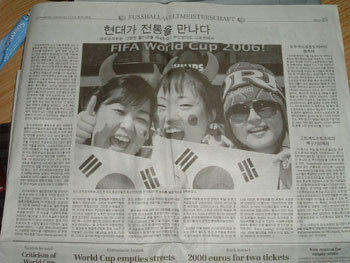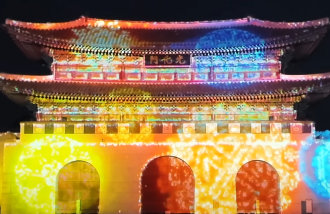Leipzig Rolls Out Red Carpet for Korea
Leipzig Rolls Out Red Carpet for Korea
Posted June. 19, 2006 03:02,

Among the 12 cities in Germany hosting World Cup games, Leipzig is the only city located in the former territory of East Germany. In this beautiful and historic city where Johann Wolfgang von Goethe and Friedrich Wilhelm Nietzsche spent their youth and Johann Sebastian Bach is buried, a red wave is flowing all around. In front of the Leipzig Central Station, the biggest train station in Europe, stands a huge red billboard that reads: Welcome Korea. On the whole façade of some subway trains, Taegeukgis (national flags of Korea) and cute caricatures of the Red Devils are painted.
About five minutes away on foot from the Leipzig Central Station at the Augustus Place, thousands of Germans are watching performances of samulnori, taekwondo, and traditional fan dances alongside Korean supporters wearing red T-shirts.
Leipziger Volkszeitung, an influential local newspaper even issued a Korean page for their weekend edition. On the front page, they printed a Korean equivalent phrase of Welcome with a Taegeukgi (Korean national flag).
Wolfgang Tiefensee is the former mayor of Leipzig who contributed largely to the citys efforts to host the World Cup. Although he has now moved his position to the minister of transportation of the federal government, he visited the press club yesterday and held a press meeting under the title, Leipzig and Football, Leipzig and Korea. He reflected on the tough process the city went through to prepare for the World Cup.
Since Leipzig had a serious lack of infrastructure compared to the cities in the former West Germany, we had to go under massive construction that transfigured the city thoroughly. Even until a few months ago, it was impossible to stroll through the city because we were still furbishing subway lines, putting buildings up, and repairing the roads.
The citys old ties to football helped the city to become the only one in the formerly eastern part to survive the hosting competition. In 1900, the German Football Association (DFB) was first organized in Leipzig. Team Leipzig has also won the first German championship in 1903. Opened in 1956, the Zentralstadion was the biggest stadium in Germany, capable of holding a staggering 100,000 spectators at a time. For this World Cup, they constructed a football stadium of 44,000 seats inside the old stadium.
After reunification, citizens of the East suffered from a sense of alienation and inferiority. However, the citizens of Leipzig are recovering their self-esteem and it makes them more enthusiastic in receiving visitors, said Kim Bo-yeong (27), an international student at the University of Leipzig.
In Faust, Goethe used a famous old restaurant in Leipzig, the Auerbachs Keller, as a setting. Leipzig is also a historic site where the French hero Napoleon was defeated by the allied forces of Prussia. And Korea is warming up here to write another legend.
Jae-Yun Jung jaeyuna@donga.com





![[사설]이혜훈-김성식 깜짝 발탁… 진정성 인정받으려면](https://dimg.donga.com/c/138/175/90/1/wps/NEWS/IMAGE/2025/12/29/133059296.1.jpg)
![[이철희 칼럼]강대국 결탁의 시대가 온다](https://dimg.donga.com/c/138/175/90/1/wps/NEWS/IMAGE/2025/12/29/133059163.1.png)
